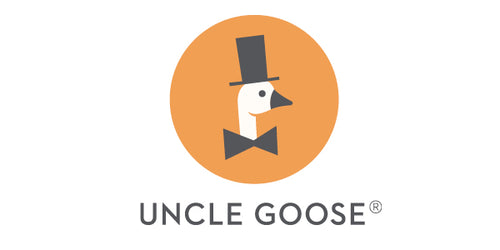
How to Unlock the Universal Secrets of Music with Chord Cubes
“Dear Uncle Goose: I’m stumped. Some of your Chord Cubes have both circles and diamonds to show where I’m supposed to put my fingers when I play guitar. What’s the difference between a circle and a diamond on the chord diagrams????”
We’ve received a few emails like that. And almost everyone who writes to ask about the meaning behind the diamonds and circles immediately writes us back after we tell them.
They all say we wish we hadn’t told them! They’re disappointed they didn’t figure it out themselves.
With that in mind — spoiler alert!
The rest of this article will explain the difference between the diamonds and the circles on our Chord Cube Guitar Blocks and our Chord Cube Ukulele Blocks. If you want to figure it out yourself: stop reading now!
Otherwise here goes:
When you learn to play guitar or ukulele, you often start with chords. A chord is a layer of several tones. You strum them all at the same time.
Every chord has a root note. That’s how chords get their names. For example, the C chord is named after the C note. The G7 chord is named after the G.
The Uncle Goose Chord Cubes are 9 blocks with chord diagrams. Because there are 6 sides to every block, this means you get to study, practice, and play 54 different chords.
Chord Cubes also come with a v-tray. This ingenious little tray holds the Chord Cube at an angle. That way, it’s tilted so you can see it while you strum.
Now, most people who use our Chord Cubes intuitively grasp this right away. They put the block in the tray. Then, they put their fingers on the strings where they see a dark circle or a diamond.
They know the six vertical lines represent the strings of the instrument. They know the horizontal lines represent the frets.
They also know if the top horizontal line is thick, it represents the nut of the instrument. (On a guitar or ukulele, the nut is near the head of the guitar. It supports the strings.)
And if the top line isn’t thick, they look to the left to see what the fret number is. And if they see a thick black line over the strings, they know they’ll be playing a bar chord.
Players may also see tiny x’s and o’s above the diagram. They come to realize the x means to not play that string. And the o’s mean to play that string “open” without a finger position, or by itself.
But what about those diamonds and circles for the finger notations? This is what separates beginning players from intermediate or advanced players.
Because after you play for a while, you come to realize the diamond represents the root note of the chord. And players will definitely want to know the root note when they start plucking each note of a chord individually, instead of simultaneously.
(Plucking each note individually is called an arpeggio. And when you play an arpeggio or a solo, you’ll want to land on that root note.)
And that’s the difference between the diamonds and circles. It’s a bit of a secret code. We like to think it unlocks the universal secrets of music!


